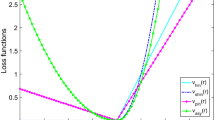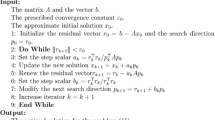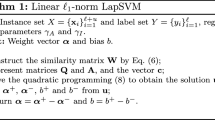Abstract
The insufficiency and contamination of supervision information are the main factors affecting the performance of support vector machines (SVMs) in real-world applications. To address this issue, novel correntropy loss functions and Laplacian SVM (LapSVM) are utilized for robust semi-supervised classification. It is known that correntropy loss functions have been used in robust learning and achieved promising results. However, the potential for more diverse priors has not been extensively explored. In this paper, a correntropy loss function induced from Laplace kernel function, called LK-loss, is applied to LapSVM for the construction of robust semi-supervised classifier. Properties of LK-loss are demonstrated including robustness, symmetry, boundedness, Fisher consistency and asymptotic approximation behaviors. Moreover, the asymmetric version of LK-loss is introduced to further improve the performance. Concave-convex procedure (CCCP) technique is used to handle the non-convexity of Laplace kernel-induced correntropy loss functions iteratively. Experimental results show that in most cases, the proposed methods have better generalization performance than the comparing ones, which demonstrate the feasibility and effectiveness of the proposed semi-supervised classification framework.




Similar content being viewed by others
References
Vapnik V (1995) The nature of statistical learning theory. Wiley, New York
Deng T, Ye D, Ma R, Fujita H, Xiong L (2020) Low-rank local tangent space embedding for subspace clustering. Inf Sci 508:1–21
Yang X, Jiang X, Tian C, Wang P, Zhou F, Fujita H (2020) Inverse projection group sparse representation for tumor classification: A low rank variation dictionary approach. Knowledge-Based Syst 196(21):105768
Zhang Y, Yang Y, Li T, Fujita H (2019) A multitask multiview clustering algorithm in heterogeneous situations based on LLE and LE. Knowledge-Based Syst 163(1):776–786
Bartlett P, Jordan M, McAuliffe J (1995) Convexity, classification, and risk bounds. J Am Stat Assoc 101(473):138–156
Huber PJ (1981) Robust estimation of a location parameter. Ann Math Statist 35(1):73–101
Huang X, Shi L, Suykens JAK (2014) Support vector machine classifier with pinball loss. IEEE Trans Pattern Anal Mach Intell 36(5):984–997
Wang L, Jia H, Li J (2008) Training robust support vector machine with smooth Ramp loss in the primal space. Neurocomputing 71(13):3020–3025
Zhong P (2012) Training robust support vector regression with smooth non-convex loss function. Optim Methods Softw 27(6):1039–1058
Wang K, Zhong P (2014) Robust non-convex least squares loss function for regression with outliers. Knowledge-Based Syst 71:290–302
Shen X, Niu L, Qi Z, Tian Y (2017) Support vector machine classifier with truncated pinball loss. Pattern Recognit 68:199–210
Yang L, Dong H (2018) Support vector machine with truncated pinball loss and its application in pattern recognition. Chemometrics Intell Lab Syst 177:89–99
Suykens JAK, Brabanter J, Lukas L, Vandewalle J (2002) Weighted least squares support vector machines: Robustness and sparse approximation. Neurocomputing 48(1):85–105
Huang X, Shi L, Suykens JAK (2014) Asymmetric least squares support vector machine classifiers. Comput Statist Data Anal 70(2):395–405
Yang X, Song Q, Cao A (2007) A weighted support vector machine for data classification. Int J Pattern Recognit Artif Intell 21(5):961–976
Rousseeuw P, Leroy A (1987) Robust regression & outlier detection. J Am Stat Assoc 31 (2):260–261
Rekha A, Abdulla M, Asharaf S (2017) Lightly trained support vector data description for novelty detection. Expert Syst Appl 85:25–32
Principe JC (2010) Information theoretic learning. Springer, New York
Santamaria I, Pokharel P, Principe JC (2006) Generalized correlation function: Definition, properties, and application to blind equalization. IEEE Trans Signal Process 54(6):2187–2197
Singh A, Principe JC (2010) A loss function for classification based on a robust similarity metric. In: Proceedings of international joint conference on neural networks IJCNN’10
He R, Hu B, Zheng W, Kong X (2011) Robust principal component analysis based on maximum correntropy criterion. IEEE Trans Image Process 20(6):1485–1494
Chen X, Yang J, Liang J, Ye Q (2012) Recursive robust least squares support vector regression based on maximum correntropy criterion. Neurocomputing 97(1):63–73
Xing H, Wang X (2013) Training extreme learning machine via regularized correntropy criterion. Neural Comput Appl 23(7):1977–1986
Hu T, Fan J, Wu Q, Zhou D (2013) Learning theory approach to minimum error entropy criterion. J Mach Learn Res 14(1):377–397
Feng Y, Huang X, Shi L, Yang Y, Suykens JAK (2015) Learning with the maximum correntropy criterion induced losses for regression. J Mach Learn Res 16(1):993–1034
Singh A, Pokharel R, Principe JC (2014) The C-loss function for pattern classification. Pattern Recognit 47(1):441–453
Xu G, Hu B, Principe JC (2018) Robust C-loss kernel classifiers. IEEE Trans Neural Netw Learn Syst 29(3):510–522
Zhu X (2008) Semi-supervised learning literature survey. Comput Sci, University of Wisconsin-Madison
Belkin M, Niyogi P (2004) Semi-supervised learning on Riemannian manifolds. Mach Learn 56(1-3):209–239
Belkin M, Niyogi P, Sindhwani V (2006) Manifold regularization: a geometric framework for learning from labeled and unlabeled examples. J Mach Learn Res 7(1):2399–2434
Bradley PS, Mangasarian OL (1998) Feature selection via concave minimization and support vector machines. In: Proceedings of international conference on machine learning ICML’98
Thi HAL, Dinh TP, Thiao M (2016) Efficient approaches for ℓ2-ℓ0 regularization and applications to feature selection in SVM. Appl Intell 45:549–565
He R, Zheng W, Tan T, Sun Z (2014) Half-quadratic-based iterative minimization for robust sparse representation. IEEE Trans Pattern Anal Mach Intell 36(2):261–275
Gomez-Chova L, Camps-Valls G, Munoz-Mari J, Calpe J (2008) Semisupervised image classification with Laplacian support vector machines. IEEE Geosci Remote Sens Lett 5(3):336–340
Munoz-Mari J, Bovolo F, Gomez-Chova L, Bruzzone L, Camps-Valls G (2010) Semi-supervised one-class support vector machines for classification of remote sensing data. IEEE Trans Geosci Remote Sens 48(8):3188–3197
Qi Z, Tian Y, Shi Y (2012) Laplacian twin support vector machine for semi-supervised classification. Neural Netw 35(11):46–53
Yang Z, Xu Y (2016) Laplacian twin parametric-margin support vector machine for semi-supervised classification. Neurocomputing 171:325–334
Yang L, Ren Z, Wang Y, Dong H (2017) A robust regression framework with Laplace kernel-induced loss. Neural Comput 29(11):3014–3039. 16(1):1063–1101
Yuille AL, Rangarajan A (2003) The concave-convex procedure. Neural Comput 15(4):915–936
Thi HAL, Dinh TP (2005) The DC (difference of convex functions) programming and DCA revisited with DC models of real world non-convex optimization problems. Ann Oper Res 133:23–46
Fung G, Mangasarian OL (2001) Semi-supervised support vector machines for unlabeled data classification. Optim Method Softw 15:29–44
Neumann J, Schnörr C, Steidl G (2005) Combined SVM-based feature selection and classification. Mach Learn 61:129–150
Liu W, Pokharel PP, Principe JC (2007) Correntropy: Properties and applications in non-Gaussian signal processing. IEEE Trans Signal Process 55(11):5286–5298
Lin Y (2004) A note on margin-based loss functions in classification. Stat Probab Lett 68(1):73–82
Steinwart I, Hush D, Scovel C (2011) Training SVMs without offset. J Mach Learn Res 12 (1):141–202
Yang L, Dong H (2019) Robust support vector machine with generalized quantile loss for classification and regression. Appl Soft Comput 81:105483
Sriperumbudur BK, Lanckriet GRG (2009) On convergence rate of concave–convex procedure. In: Proceedings of advances in neural information processing systems NIPS’09
Yang L, Zhang S (2016) A sparse extreme learning machine framework by continuous optimization algorithms and its application in pattern recognition. Eng Appl Artif Intell 53:176–189
Dua D, Graff C (2019) UCI machine learning repository (http://archive.ics.uci.edu/ml)
Suykens JAK, Vandewalle J (1999) Least squares support vector machine classifiers. Neural Process Lett 9:293–300
Wu Y, Liu Y (2013) Adaptively weighted large margin classifiers. J Comput Graph Stat 22 (2):416–432
Xu G, Cao Z, Hu B, Principe JC (2017) Robust support vector machines based on the rescaled hinge loss function. Pattern Recognit 63:139–148
Acknowledgements
This work is supported by National Nature Science Foundation of China (No. 11471010, 11271367). Moreover, the authors thank very the referees and the editor for their constructive comments. Their suggestions improved the paper significantly.
Author information
Authors and Affiliations
Corresponding author
Additional information
Publisher’s note
Springer Nature remains neutral with regard to jurisdictional claims in published maps and institutional affiliations.
Rights and permissions
About this article
Cite this article
Dong, H., Yang, L. & Wang, X. Robust semi-supervised support vector machines with Laplace kernel-induced correntropy loss functions. Appl Intell 51, 819–833 (2021). https://doi.org/10.1007/s10489-020-01865-3
Published:
Issue Date:
DOI: https://doi.org/10.1007/s10489-020-01865-3




